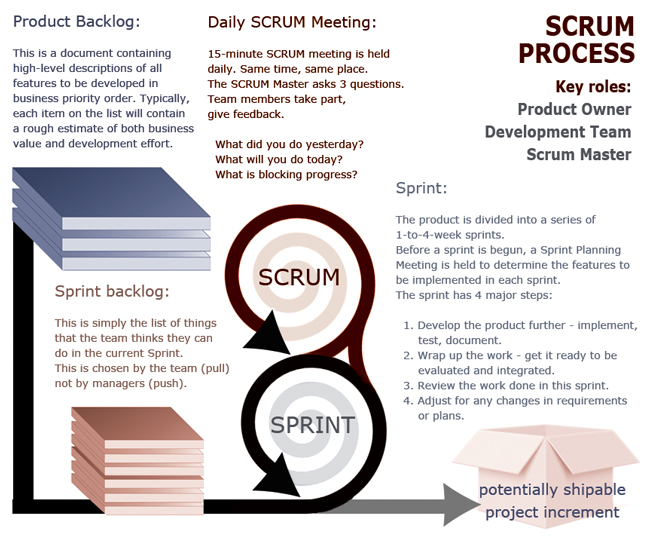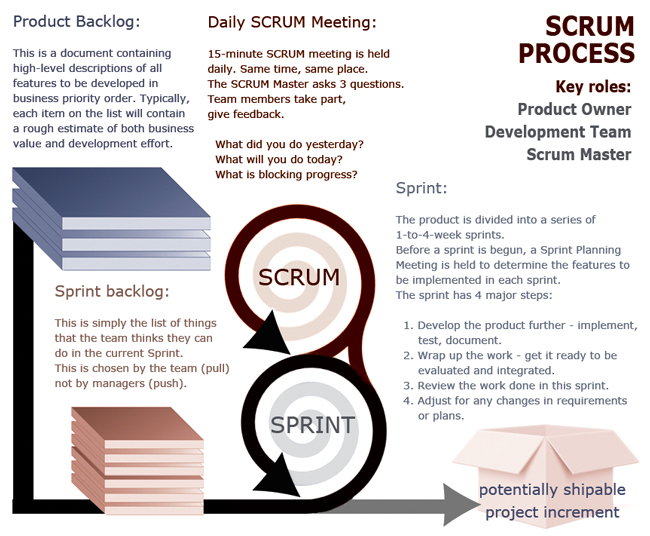Andy Trainer
17 Feb 2012
Stand Up Meetings - Learning from Scrum & Agile Project Management
Stand up meetings - also called Scrum meetings - are an important factor of Scrum project management. Scrum is a form of agile project management that breaks projects down into smaller, easier to manage chunks that are completed as sprints.
Daily Scrum meetings are important as the method is so changeable. They ensure that everybody is on track and minimise the chances of two team members performing the same task. However, because they are daily they must be kept short and so Scrum meetings are usually stand up meetings.
Learn more about Scrum and become accredited with Scrum Training. We run accredited ScrumMaster Training and Scrum Product Owner Training. If you wish to learn a different Agile methodology then we also provide APMG accredited Agile Project Management Training. We train to both Agile Project Management Foundation and Agile Project Management Practitioner levels.
The Scrum process is explained in the graphic below:

For more information on Agile and Scrum read What Is Agile Project Management?
Why Stand Up?
We have already established that stand up meetings are an important part of Scrum as they help keep project on track. But why stand up? Why not have a 15 minute sit down meeting?
The logic behind stand up meetings is that it is uncomfortable to stand for long periods. This encourages participants in the meeting to cover more in less time. It is harder to become sidetracked because the team is anxious to get back to their desks.
Daily scrum meetings are meant for synchronisation and not for problem solving, that can be left to other more extensive meetings.

What could the Young Apprentices have learnt from Agile Project Management?
Standing uncomfortably also limits the chances of two participants arguing or discussing details that are not crucial to the meeting as a whole. Having all the other members of the team standing and staring at them will soon bring any 1 to 1 discussion to a close.
Scrum does not have to be the only methodology that uses stand up meetings, they are a successful tool for any work process that requires quick updates without the waffle.
3 Tips for Successful Stand-Up Meetings
1. Start On Time
The whole point of stand-up meetings is to be quick. If a 10-minute meeting starts 5 minutes late then it is really an unproductive 15-minute meeting for those who turned up on time.
Stand up meetings should start on time to the second. There should be no scope for team members to be late.
2. Eliminate Waffle
Not the edible kind, the unproductive kind. The ScrumMaster (who leads the Scrum meeting) or project manager should recognise when a meeting is going off track and bring it back to task.
This should happen in all meetings anyway but is even more important for stand up meetings. When limiting a meeting to 5-15 minutes everything should be important and to the point.
3. Talk to Each Other, not to the ScrumMaster
As the Scrum Master is driving the project, there is a tendency for team members to report directly to them during daily meetings. However, the meetings are designed for the whole team to synchronise. Reporting to the ScrumMaster should be a separate act.
Stand up meetings are for team members, not for managers. The manager should be asking questions, not giving answers.
Potential Problems with Stand Up Meetings
Scepticism
A lot of developers are sceptical of stand-up meetings and this scepticism usually goes hand in hand with a mistrust of Scrum itself. Total buy-in from the whole team is vital for Scrum to work. Just one sceptic can ruin the whole process.
If everyone has not bought into the idea of stand-up meetings then they won't work, and so more people will believe they don't work.
Replacements for Real Meetings
Daily Scrums are simply checkpoints to keep everybody in touch. They should not replace lengthier sit-down meetings which are more structured and more productive.
No Structure
Unlike more formal meetings, Scrums do not usually have agendas. Nobody knows when to speak or what is most important. This can be solved by appointing a convener - preferably not a manager. This keeps the meeting on track without a manager taking over.
